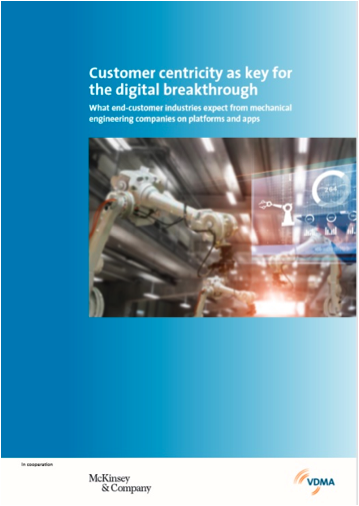Customer centricity as key for the digital breakthrough
The Mechanical Engineering Industry Association (VDMA) in Germany examined together with McKinsey & Company the area of digital platforms and applications. Despite a number of success stories, diverse efforts and investments, the industry of mechanical and plant engineering companies has yet to see a breakthrough on a broader scale in the digital solutions business. This new publication focuses on some pivotal questions: How do the mechanical and plant engineering companies in Europa view the topic of digital platforms and applications? Where does the industry currently stand and how do companies assess their customer expectations in the digital sphere? Do digital platforms and applications offer a compelling opportunity for a separate business model in parallel to the sale of machinery and equipment?
 The present study outlines insights critical for success, gives differentiated recommendations for action with respect to specific end-customer industries, and shows how decision-makers in the mechanical and plant engineering sector can optimally design customer-specific strategies for digital solutions.
The present study outlines insights critical for success, gives differentiated recommendations for action with respect to specific end-customer industries, and shows how decision-makers in the mechanical and plant engineering sector can optimally design customer-specific strategies for digital solutions.
Customer-centric, in theory, is fairly self-explanatory. But, businesses that take a customer-centric approach do more than say they put their customers first; they make it a priority to provide an exceptional customer experience at the point of sale and after the sale to increase profits and gain a competitive edge. Truly customer-centric organizations identify their most valuable customers and ensure their satisfaction. In order to do this, organizations gather customer data from multiple sources and channels and target their most profitable customers with relevant offers at the right time.
Customer-centric is nothing new, but it is becoming increasingly important in today’s age of the customer to create a corporate customer culture and manage the customer experience, when organizations especially in B-to-B industries are undergoing digital marketing transformation. Customer-centricity needs to become a mindset across the organization with buy-in from all stakeholders, because all departments need to work from a customer-centric standpoint rather than a product-centric perspective to profit from the most valuable customers. Customer centricity also changes the way how companies work with IP and generate their patent portfolio. Customer centric companies use IP design to create patents for unique customer experiences, use cases, customer journeys and human machine interfaces. Their patent portfolio also reflects the focus on customers and not on products, features or technology.



